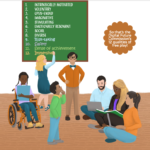
We need to find people who are using social media in positive, thoughtful, and intellectual ways. That will give kids a model, a way to think about social media positively. Then we will end up with less things like cyberbullying because we would have taught them to use these tools in better ways.
—Jordan Shapiro, in conversation with Matthew Farber
I’m backing my way into writing a review (slowly but surely) of Jordan Shapiro’s new book, The New Childhood: Raising Kids to Thrive in a Connected World. I ran across another interview with Shapiro, this one by Matthew Farber, Ed.D., Assistant Professor of Technology, Innovation, and Pedagogy at the University of Northern Colorado. Farber asks 4 questions. The quote above is an excerpt from Shapiro’s answer to question 2: I’ve heard you ask, “How can we expect Twitter to get smart if we never taught anyone how to use it smartly?” Can you explain what you mean by that?
Not many kids are using Twitter but they might be interested in your Twitter feed if you have one. How did you select the people you follow? Who do you actually look forward to hearing from and why? I used Twitter extensively once upon a time as an educator/curator working deep and wide in the digital space. I use it much less frequently today but among the 868 individuals and organizations I currently follow, I look forward to posts from Open Culture such as this one about a new digital exhibition of Vincent Van Gogh’s work at the Atelier de Lumieres in Paris. The people behind @openculture do a brilliant job curating an incredible range of “cultural & educational media for the worldwide lifelong learning community.”
Instagram has emerged as an important networked public for many young people today. I was drawn there initially by the visual focus. I stay for the inspiration I find. Thanks to an artist friend’s recommendation of @dailybirdpix, I have tapped into a network of wildlife photographers who are enriching my life. I’m connecting with people and organizations in my local fibershed. I’m appreciating the daily arrangements that my local florist shares. I’m inspired by @AustinKleon‘s sense of humor, creative process, and collaborations with his kids. I look forward to the “stories” one young friend of mine shares because she’s so committed to living this life fully and she’s funny as hell.
Imagine you’re a stranger to yourself and your family. What could you learn about yourself from your presence (some would say footprint) or lack of one on various social media channels? If your kids are older, open up your “following” lists, look at your feeds, and notice what you discover about each other. Talk about it. Remember to create a safe space. No judgments. Open minded, playful. Ask each other who you think is using the tools really well, who not so well, and why. Explore who your favorite people follow. What can you learn from them?
To date, I’ve read (and listened to) several reviews and interviews with Shapiro and I’m struck by the awareness that no one comes close to capturing what he’s talking about in the book. Not even close. Once again, my experience confirms that sometimes you just have to do the work of reading the full version. This book is worth the work. Let me know if you’re up for reading it. If you”re interested, I’ll schedule a few conversations via Zoom to talk about it with you. The more the merrier…


